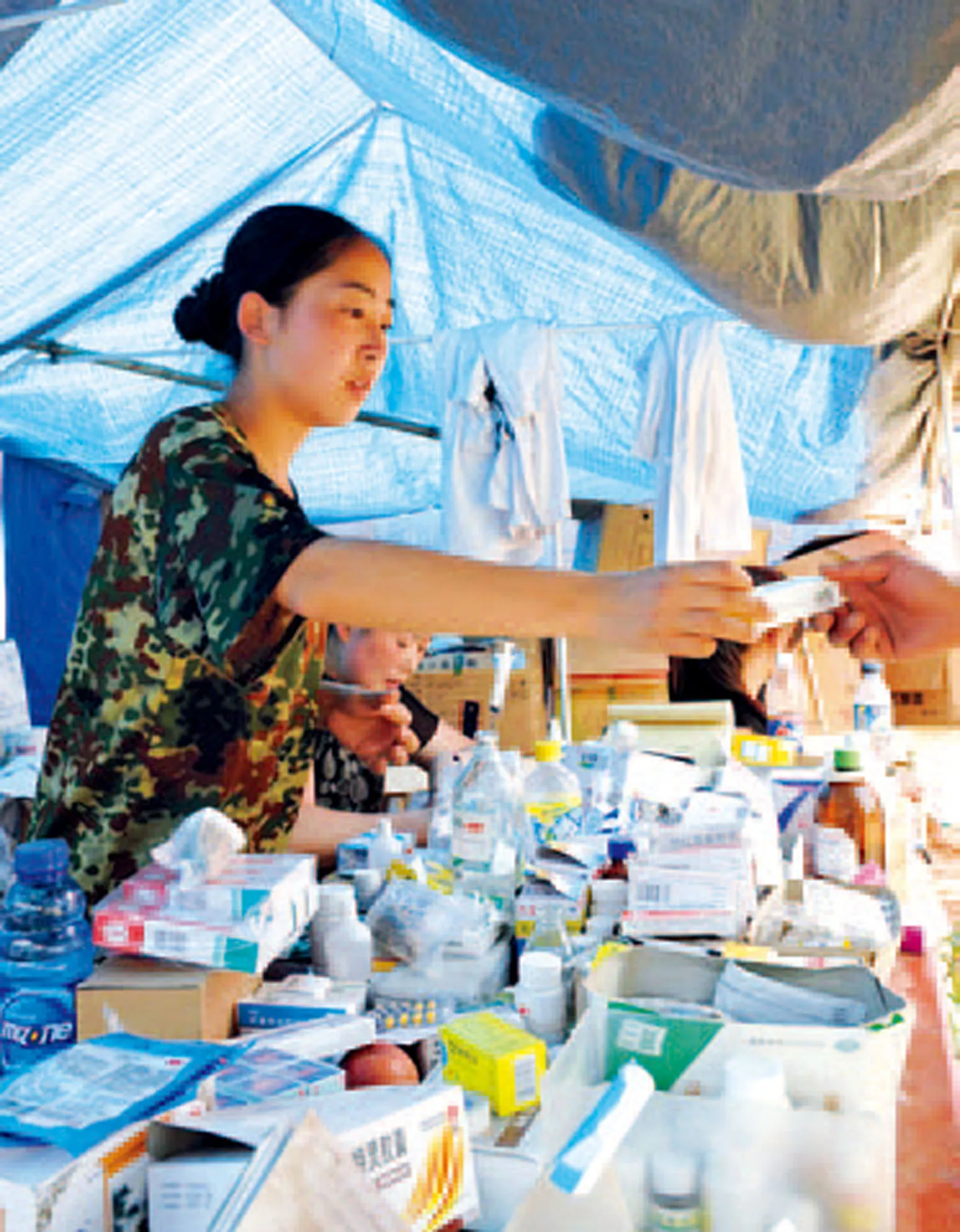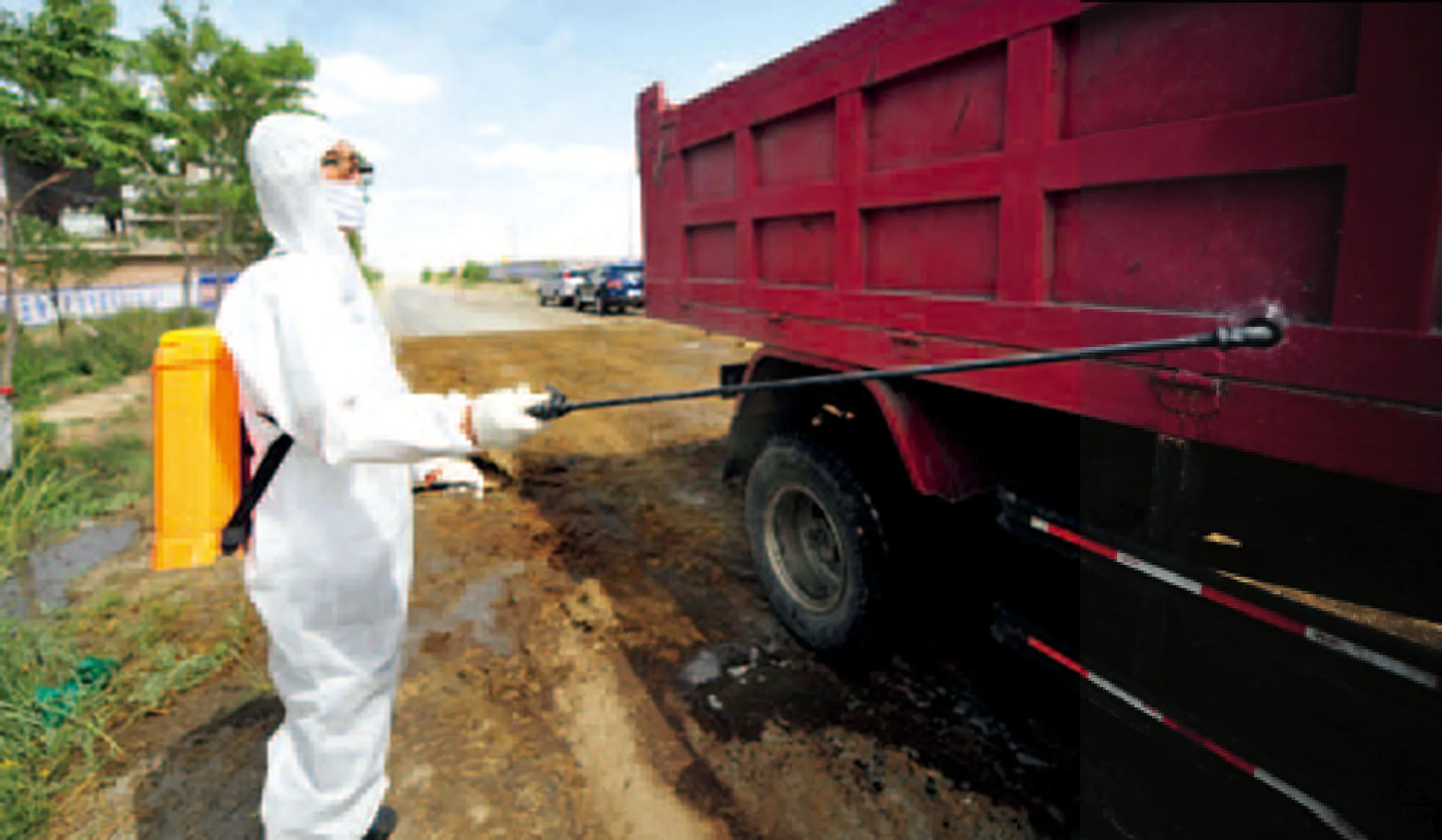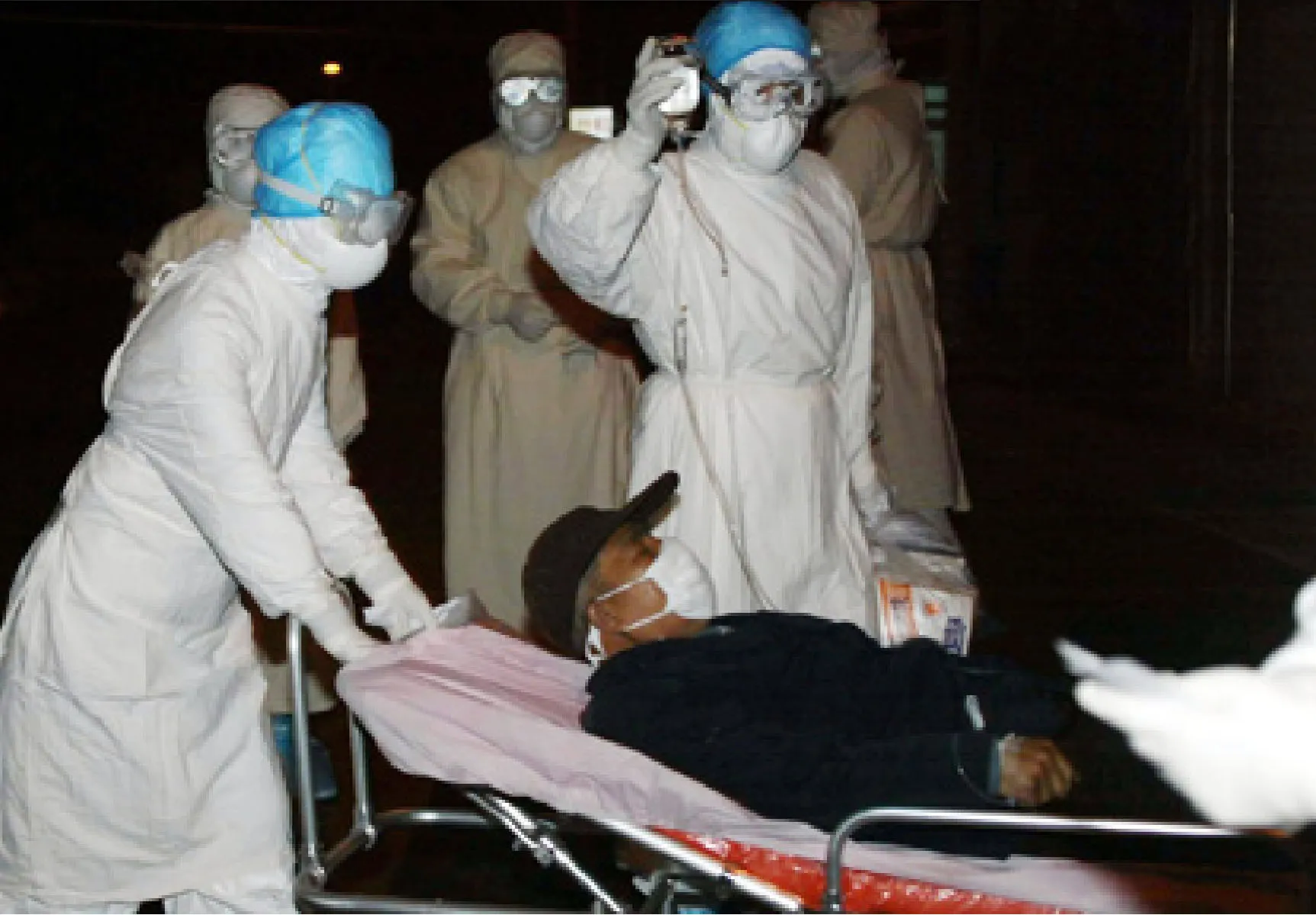Learning From SARS
2013-12-08ByTangYuankai
By Tang Yuankai
Experience of fighting a massive epidemic outbreak translates into action and determination overhauling disease control system

TIMELY AID: A disease control worker hands out disinfectants and most commonly used drugs to people who live in tents after a catastrophic earthquake in Wenchuan, Sichuan Province,on May 12, 2008
On January 23, 2002 the Ministry of Health founded the Chinese Center for Disease Control and Prevention (CDC) as an effort to monitor and control the spread of major diseases. In the same year, the nascent organization was overwhelmed by a major outbreak that it was simply too inexperienced to handle.
In November 2002, the first known case of severe acute respiratory syndrome (SARS) was reported in south China’s Guangdong Province,and the viral outbreak quickly spread elsewhere in the country as well as to some other countries and regions.
“When the outbreak of SARS occurred, the formation of the CDC was still underway as it had combined four smaller departments. Back then, the concept of disease control was novel to the public and local anti-epidemic agencies had yet to be in place,” recalled Li Liming,founding director of the CDC.
Ten years later, Li said that SARS arrived too early and caught the fledgling organization by surprise. “Only if I was given three more years to prepare our working system for an epidemic of such scale, we could have handled it much better,” Li said.
During China’s early fight against the SARS outbreak, the CDC’s priority was to identify the cause. Over time, there was a major shift of policy in putting the CDC in charge of curbing transmission, said Zeng Guang, 67, chief CDC epidemiologist.
Although the SARS epidemic exerted heavy tolls on China’s health and economy, the virus was effectively contained. On August 16, 2003 the Ministry of Health announced that a total of 5,327 SARS cases were reported on the Chinese mainland and the death toll stood at 349.
At the opening meeting of this year’s full session of the National People’s Congress (NPC),China’s top legislature, on March 5, Premier Wen Jiabao said, “An important lesson we learned in our response to the sudden outbreak of SARS in 2003 is that economic development and social development need to be coordinated.”
“China had a lot of landmark events hap-pening during the last decade while SARS is the only disease singled out in the government work report,”said Wang Yu, current director of the CDC. “It showed that the leadership learned an unforgettable lesson from SARS in terms of upgrading guiding principles of governance and social development models,which will have long-term impacts on China’s development.”

ANTICIPATION: A flu epidemic drill is held in an airport in Xi’an, capital of northwest China’s Shaanxi Province, on May 12, 2009
Crisis response
Before the SARS epidemic hit China, the country had neither a command system for public health emergencies nor clear regulations on which agencies are responsible for rating these events and taking action. The government was not compelled by any law or regulation to publicize information, inform the public, mobilize resources or take quarantine measures in cases of a health emergency.
China’s national county-based disease control and prevention network took shape in the 1950s with trained professionals graduating from public health programs. Despite the remarkable achievements this monitoring system made in controlling epidemics, its efficiency was severely undermined by the shortage of government input at the beginning of this century.
Between the end of 2002 and early 2003,fear about being infected with SARS circulated quickly among people in Guangdong, where the SARS virus originated, and the lack of official figures of actual cases caused an information vacuum that was filled by sensational rumors.Plagued by anxiety, residents started to stock up on white vinegar and Chinese herbal medicine that were believed to be effective against the virus. This shopping craze caused price spikes and speculation on these erstwhile daily necessities.
Shortly after arriving in Guangdong as the head of an epidemic research team, Zeng suggested to the Central Government that the most urgent task was not to tell the public what the causal agent was, but the timely update of actual cases. Zeng found that many hospitals covered up con firmed cases as staff members were afraid of being held responsible for new infections and unreported cases severely impeded accurate evaluation of the outbreak.
After returning to Beijing, Zeng investigated the situation in major hospitals. He learned that many patients treated for other diseases and medical workers were picking up the SARS virus there. On April 22, 2003 Zeng visited Peking University People’s Hospital, which allegedly had the most severe cases of cross infection among local hospitals. He warned that new cases would skyrocket without effective quarantine measures, and suggested all SARS patients in Beijing’s hospitals be immediately transferred to a designated suburban hospital.
The Beijing Municipal Government took Zeng’s advice and quarantined the hospital the very next day. In addition, a comprehensive facility with state-of-the-art equipment was assembled within seven days by 7,000 workers working around the clock in Beijing’s northern suburb of Xiaotangshan Township, Changping District.
Zeng said that during the following days,his opinions received unprecedented attention from government decision makers. “We disease control experts were consulted before almost every decision was made,” he said, adding that was widely different from earlier stages of the epidemic when officials focused on finding a clinical treatment and developing a vaccine.
According to Zeng, as early as January 2003 he found that transmission of SARS only occurred after people had close contact with patients showing symptoms and suggested quarantine measures. However, medical resources were concentrating on identifying the pathogen, and voices from disease control experts were ignored until it was too late.
Liu Qi, then Secretary of the Beijing Municipal Committee of the Communist Party of China (CPC), reportedly told Zeng that Beijing would have 100 fewer SARS patients if he could have heard Zeng’s suggestions 10 days earlier.
Immediately after being appointed as member of an expert panel on SARS control directly under the State Council, China’s cabinet, in late April, Zeng asked the Beijing Health Bureau to establish an outbreak information system to collect the actual number of cases from each medical facility.
“We had the true number of total cases in Guangdong but we didn’t have that figure in Beijing. In the past, some officials thought we needed to keep this information a secret.However, how could we effectively respond to this epidemic without knowing the correct figures?” he said.
Zeng gave a 40-minute lecture to China’s top leadership, including then President Hu Jintao, on April 28, 2003. He said that he remembered seeing Hu nodding his head when hearing about publicizing the status of the SARS outbreak.
Before Zeng’s lecture, President Hu, also General Secretary of the Communist Party of China (CPC) Central Committee, warned all levels of government against laxity in reporting SARS cases at a meeting of the Standing Committee of the Political Bureau of the CPC Central Committee.
On April 20, 2003 Beijing Mayor Meng Xuenong and Minister of Health Zhang Wenkang were removed from their positions,and a national command center for SARS prevention and treatment was set up. On the same day, the Ministry of Health mandated daily reports from all provinces on new cases and prevention measures.
On April 23, the central treasury set up a 2-billion-yuan ($322 million) fund for controlling SARS.
On May 9, the State Council released Regulations on the Handling of Public Health Emergencies. Its drafting and adoption were completed within a record-breaking 15 days.
“As the country’s first ever regulations on public health emergency handling, they define duties and responsibilities of various government departments. They serve as the first legal instrument for building an emergency response mechanism and a complete legal framework for handling public health emergencies in the future, as well as provide guidance for local governments of all levels for building their own emergency response programs,” said Song Ruilin, who headed the drafting team of the regulations.
Zeng said that instead of any advanced technology, containing SARS only required timely release of the outbreak status information, quarantine measures to cut off further infection and special protection for high-risk groups. “The severity of the outbreak was due to China’s weak public health monitoring system with too many loose links,” he noted.
“It became clear to us that public health services and control of major epidemics concern not only health authorities but the whole society. The government should take the primary responsibility,” said Wang Longde, then vice Minister of Health.
A mature mechanism
After the SARS outbreak, the Ministry of Health set up a medical emergency response office in early 2004.

RAPID RESPONSE: A disease control worker sterilizes a vehicle on its way out of Luyang Township, Jingtai County,northwest China’s Gansu Province, on June 7, 2012,immediately after an outbreak of avian flu was con firmed
In August 2007, the Emergency Response Law was adopted by the NPC Standing Committee. According to the law, all ministries quickly formulated their emergency response plans, covering circumstances including severe epidemics, natural disasters, poisoning incidents, environmental pollution, nuclear leaks and major railway, civil aviation, power and coalmine accidents.
“The emergency response planning started in China in the field of disease control, which permeated the entire field of public health and eventually covered all kinds of safety hazards.This progress can be regarded as a legacy of the SARS outbreak,” Zeng said.
Over the past decade, the Law on the Prevention and Treatment of Infectious Diseases, the Frontier Health and Quarantine Law and the Animal Epidemic Prevention Law were also amended to become more effective in containing the spread of infectious diseases after revision.
According to Wang Yu, over the past decade, China’s disease control system has made great progress, where passive reaction to an ongoing pandemic has been replaced by response planning in advance and isolated reactions taken by local authorities replaced by systematic and joint efforts. He said that the whole country has already been covered by a network of controlling and treating infectious diseases.
Wang’s daily work includes checking the daily update of infectious disease cases collected by local disease control and prevention agencies from across the country by logging into an internal database from his computer.Even cases of unknown diseases will be reported through this system.
“This system is useful for us to collect information timely and obtain the disease spectrums of specific regions and age groups in the long term, which can be used as reference for the government’s decision making and planning of investment in local health services,” Li said.
Li is the first person to suggest the establishment of such a un ified national information system to the Central Government. When then vice Premier Wu Yi visited the CDC on April 1, 2003 in the heat of the SARS outbreak, Li highlighted the need for a national information system, which would alert the center of a new SARS case in the country immediately.
The system proved to be pivotal in containing the later spread of avian and swine flu viruses in China.
On April 2, 2009 a four-year-old boy in Mexico was diagnosed with swine flu which is considered the first case of the H1N1 strain infecting humans.
On April 25 that year, the WHO declared the H1N1 outbreak a public health emergency of international concern. Four days later, the WHO raised the in fluenza pandemic alert from phase 4 to phase 5, signaling that a pandemic was imminent, and requested that all countries and regions immediately activate preparedness plans and be on high alert for unusual outbreaks of in fluenza-like illness and severe pneumonia.

ISOLATED TREATMENT: A patient is wheeled into Beijing’s designated SARS facility in suburban Xiaotangshan Township on May 19, 2003
The Chinese disease control system responded swiftly to brace for the possibility. On April 30, 2009 all passengers and crew members of flight AM098, the first direct flight from Mexico to China’s mainland since the outbreak began, received quarantine checkups upon arrival in Shanghai. Two days earlier, a pandemic emergency response system was activated in Shanghai where even community-level clinics were required to screen patients with fevers for swine flu. The response plan was made after the SARS outbreak and proved useful for controlling bird flu at the end of 2003.
After Hong Kong con firmed its first human H1N1 case on May 1, 2009 Mao Qun’an, then spokesman for the Ministry of Health, told the Xinhua News Agency on the same day that the ministry had been ramping up surveillance and disease control arrangements for a worst-case scenario. Ten days later, the ministry released information about the first H1N1 case on the Chinese mainland on the day it was con firmed.
Zhong Nanshan, a renowned respiratory disease expert who is also known for giving out early warnings about the transmission of SARS,said that China’s response to the H1N1 outbreak was totally different from the response to SARS, as “preventive measures were taken early on so as to avoid waste of medical resources due to ineptitude later.”
Thanks to the timely information of the public on new cases and the government’s comprehensive, multi-faceted and swift response, the H1N1 outbreak didn’t cause mass panic in China.
Clinical tests of China’s H1N1 vaccines kicked off in July 2009, supervised by the CDC.
Liang Wannian, Deputy Director of an office in charge of health care reform under the Ministry of Health, said at a forum on public health emergencies in Beijing last November that China has built up a national public health emergency management system and 27 national emergency teams respectively in charge of emergency medical rescue,infectious diseases control, poisoning treatment and medical services concerning nuclear and radiological threats.
Xu Ke, vice Minister of Health, said at the same forum that over the past decade China had successfully controlled severe epidemics and handled medical emergencies caused by disasters like the catastrophic earthquake in Wenchuan, Sichuan Province, on May 12, 2008.
New challenges
Yao Zhibin, who was appointed head of the Health Department of Guangdong during the SARS outbreak, said in March that the province is much better prepared in terms of epidemiological monitoring and medical service levels for an epidemic like the SARS outbreak. Yao said that governments of all levels in Guangdong had injected around 20 billion yuan ($3.22 billion) into improving local disease control and prevention system over the past decade. Last year, China’s first provincial-level hospital dedicated to handling public health emergencies was put into use in Guangdong.
However, cover-ups of epidemics still exist as some local officials still worried that “real casualty numbers” would become an impediment to the future of their careers. Moreover, some experts point out that although the CDC has established a vertical system with local branches, the center can hardly mandate them in daily operation.
Li calls for more government intervention to address the problems. “Government’s forceful intervention is the key to China’s victory against the SARS outbreak,” Li said. He believes that public health is not only related to a country’s medical level, but also a society’s overall economic, cultural and scientific development levels and political circumstances.
Since the beginning of this year, hazy weather has affected a vast area in China and lasted for days in some cities where many residents chose to wear facial masks during outdoor activities for self-protection against air pollution. “However, no systematic evaluation of the smoggy weather on human health is available in China,” said Wang Yu in March.
Wang said that an institute under the CDC was conducting comprehensive research on impacts of haze on human health and would shortly launch a risk alert system. In his opinion,disease control and prevention agencies should play a leading role in the establishment of a nationwide system to cope with hazy weatherrelated medical emergencies. ■
